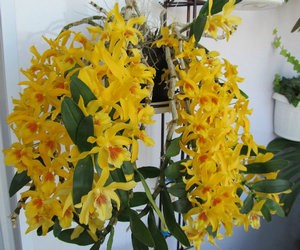
Dendrobium nobile care after flowering. The Dendrobium nobile orchid is a noble beauty.
One of the most popular varieties of orchids of the Dendrobium genus is the Dendrobium nobile flower. In its natural environment, this ornamental flowering plant can be found in regions with a temperate climate - in Africa, Indonesia, China and the Himalayas. Blooming for months, this beautiful orchid will be a real decoration of the house. What conditions should be provided to her at home - advice from an orchidist.
Description of the species Dendrobium nobile
 Orchid dendrobium nobile is a flower with an erect stem, at the base of which pseudobulbs are formed. The root system is white, massive. The leaves are dense, lanceolate, arranged alternately. Flower buds are formed in leaf axils in several pieces. The flowers are highly decorative, thin out a pleasant aroma. The life cycle of each shoot varies from two to four years, after which the shoots die off.
Orchid dendrobium nobile is a flower with an erect stem, at the base of which pseudobulbs are formed. The root system is white, massive. The leaves are dense, lanceolate, arranged alternately. Flower buds are formed in leaf axils in several pieces. The flowers are highly decorative, thin out a pleasant aroma. The life cycle of each shoot varies from two to four years, after which the shoots die off.
Dendrobium nobile is one of the most charming orchids. Depending on the species, the flowers that densely cover the shoots can be of the most diverse colors - orange, snow-white, rich yellow and purple.
The success of growing this flower depends on how close the conditions of its growth at home will be to the conditions of its natural habitat. Otherwise, this plant will wither and generally degenerate. Optimal growing conditions for this flower can be provided if it is placed in a private house or on a loggia.
Unlike other ornamental flowering plants, dendrobium nobile blooms in winter. And this is its main feature.
After the flower has faded, it begins its growing season. Young shoots grow from pseudobulbs, the root system is actively developing. Intensive growth of orchids falls on the spring-summer period. With the advent of autumn, when the flower has faded, the dormant phase begins. The end of this period will be indicated by the appearance of flower buds on pseudobulbs.
Growing conditions and care
Caring for dendrobium nobile at home is not considered difficult, the main thing is to follow some rules in this process.
Lighting
This is a light-loving plant, so it is always placed on the windowsills on the south and south-west sides. If it is not possible to provide the flower with natural light, artificial lighting with fluorescent lamps will be required. The Dendrobium nobile orchid loves fresh air. Therefore, in the warm season, he needs to be aired frequently or kept outdoors with protection from direct sun.
It is not recommended to immediately expose newly acquired specimens to sunlight. This can cause burns to plants. Leaves, as indicators, help to determine the lack or excess of light. In good light, the leaves of the flower will be a light green color. If the leaves darken or turn yellow, then the plant does not have enough light.
Orchid dendrobium nobile, in which the leaves turn yellow en masse, needs bright lighting. The foliage of a plant that is located in direct sun brightens over time. This problem can be eliminated by moving the plant to a shaded area.
A flowering plant can be brought to a warmer place with good lighting to ensure continued flowering. A sudden change in light can cause flower buds to drop.
Wet mode
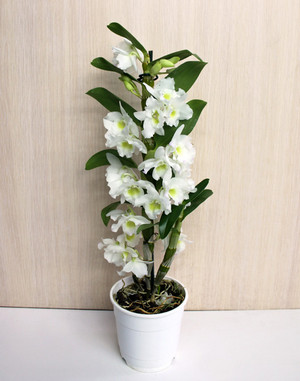 During the period of building green mass and root system, the orchid should be watered frequently and plentifully. Each subsequent soil moistening should be done only after the surface earthen clod has dried. In its natural environment, this plant grows right on the trees. Its roots are in a free position, dry out quickly and do not tolerate excessive waterlogging.
During the period of building green mass and root system, the orchid should be watered frequently and plentifully. Each subsequent soil moistening should be done only after the surface earthen clod has dried. In its natural environment, this plant grows right on the trees. Its roots are in a free position, dry out quickly and do not tolerate excessive waterlogging.
Watering the flower is done by immersing the flowerpot in water for five minutes. Moisturizing the plants is stopped after the shoots stop their growth. Feeding the flower during this period is also not recommended. Such care is resumed only after the plant begins to produce flower buds, not earlier. Earlier nutrition and hydration can stimulate the growth of vegetative buds and the formation of children. An excess of nutrients in the soil leads to the fact that the leaves and shoots of the plant turn yellow.
Orchid dendrobium nobile does not need high humidity. This is due to its keeping cool in winter and outdoors in summer. You need to spray the flower only on hot summer days.
Temperature regime
ABOUT 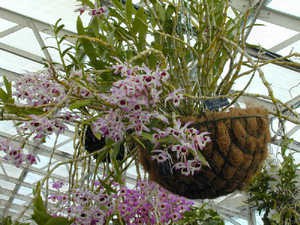 The optimum temperature for Dendrobium Nobile during the day is twenty-three degrees, at night - twenty degrees. At elevated temperatures, this flower stops its growth.
The optimum temperature for Dendrobium Nobile during the day is twenty-three degrees, at night - twenty degrees. At elevated temperatures, this flower stops its growth.
In autumn, as soon as the flower has faded, it is provided with coolness with a large fluctuation in daily temperatures - about ten degrees. Artificial temperature fluctuations for this plant are possible provided there is good lighting and no watering. Such conditions are a stimulus for laying flower buds.
top dressing
The main care for this exotic at home includes periodic top dressing. The plant is fertilized from the beginning of the formation of flower buds until the end of the development of young shoots. The first and last time top dressing is carried out with a dose two times less than the recommended one. To fertilize the dendrobium nobile, use special top dressing for orchids.
Transfer
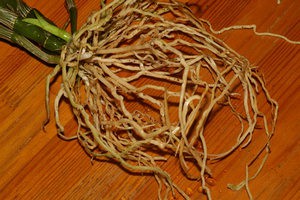 At home, orchid transplantation is carried out only in extreme cases: when the plant is sick, there is not enough space for it in the pot, or if it is necessary to replace the old soil with a new one. You can transplant healthy plants no more than once every three years.
At home, orchid transplantation is carried out only in extreme cases: when the plant is sick, there is not enough space for it in the pot, or if it is necessary to replace the old soil with a new one. You can transplant healthy plants no more than once every three years.
A flower is transplanted after it has faded into a new, opaque planting container, which is three centimeters larger in diameter than the previous one. For these purposes, the bark of spruce or pine of the middle fraction is used with the addition of charcoal and sphagnum moss.
Overgrown flowers are divided into parts, seated in new containers. Each of the divisions should contain several young pseudobulbs. Old pseudo-lifes are subject to removal.
reproduction
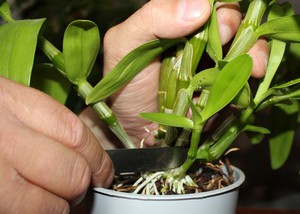 Dendrobium nobile care includes its reproduction. At home, this can be done in two ways - by dividing the pseudobulbs and cuttings.
Dendrobium nobile care includes its reproduction. At home, this can be done in two ways - by dividing the pseudobulbs and cuttings.
- The first method is used in the process of transplanting adult overgrown plants. Propagation using cuttings is carried out as follows: the old branches of the plant are cut into pieces so that each of them has several internodes, the finished planting material is placed in a mini-greenhouse on wet sphagnum moss.
- Further care for the cuttings is to ensure a stable temperature regime within 23-26 degrees. If everything is done correctly, then in two to three weeks, child shoots will appear on the nodes.
- Young shoots, up to five centimeters long, on which there are roots and leaves, are separated from the cuttings and planted in separate containers with fine-grained bark. Such reproduction has brought success to many flower growers.
Diseases
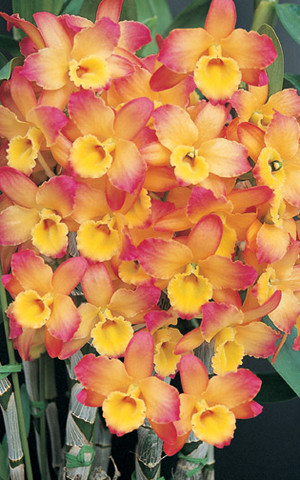 It's soft and very beautiful plant not resistant to diseases and pests at home. main reason this is the wrong care.
It's soft and very beautiful plant not resistant to diseases and pests at home. main reason this is the wrong care.
The main conditions for the successful cultivation of this flower at home are competent care, proper transplantation and reproduction.
The Dendrobium nobile orchid belongs to the Dendrobium orchid genus native to Australia and South Asia. Distinguished by the most beautiful appearance, graceful stems, bright rich flowers of various shades, delicious aroma.
Dendrobium nobile is a perennial herb. The name translated from Latin means famous, noble, excellent, etc. A medium sized plant with fleshy stems and oblong leathery leaves.
In its pure form, the Dendrobium nobile orchid is very difficult to find. Almost all plants sold in flower shops are hybrids in one way or another.
Expanded clay is poured at the bottom of the pot. After that, a flower is carefully rolled into it and sprinkled with earth on top. After planting the orchid, the soil must be moistened again, but not overwatered, as this can cause root rot.
The orchid can also be grown in special blocks, without soil. The most important thing here is to prevent the roots from drying out. If the roots dry out, the leaves on the plant will turn yellow, and the orchid itself will begin to wither.
To prevent this from happening, lay out the block with sphagnum (live or dry) and make sure that it is always moderately wet.
Watering
In nature, the Dendrobium nobile orchid grows in a tropical climate, the rainy season alternates with a dry period. learned to adapt to such conditions. But since the level of humidity accelerates or slows down the process of flower development, one must learn to adapt to these features.
If the orchid is grown in a flower pot, it should be watered once every 2 days, if in blocks - daily. If the orchid is grown in blocks, make sure the substrate is dry each time before watering.
There should be holes in the flower pot at the bottom so that there is an outflow of water when watering, otherwise the plant will get sick.

Orchid needs a warm shower
Periodically, the orchid needs to arrange a warm shower. This will increase and accelerate the likelihood of beautiful and long flowering. Water should be 35-37°. Pour it on top of the stem. After such procedures, the plant grows stronger, the leaves become shiny bright saturated color.
It is better to water in the morning, so that the roots of the orchid have time to dry completely during the day. If possible, it is good to put a humidifier next to the flower pot.
Instead of watering, a Dendrobium flower pot can be placed in a container of water. Water should be settled and soft without impurities. It only takes a few minutes to keep in a container of water. After that, the flower pot is placed on the fabric and waiting for the excess moisture to flow out. After that, they return to their original place.
In order not to make a mistake with watering, a wooden stick is stuck into the flower pot. They take it out and see if it is dry or not. If dry, you can water, if wet, it is better to wait.
With the onset of late autumn and winter, watering is practically stopped, as the orchid sleeps and does not consume moisture. Then the water simply flows into the cells of the plant and remains there, gradually causing the process of decay.
Spraying and top dressing
Before you start spraying an orchid, you need to keep in mind that this should be done only in the summer at high air temperatures. In this case, the plant should not be under the scorching rays of the sun, otherwise burns form on the leaves during the evaporation of moisture.
In winter, spraying is not only pointless, but can also be harmful, provoking rotting of the root system.
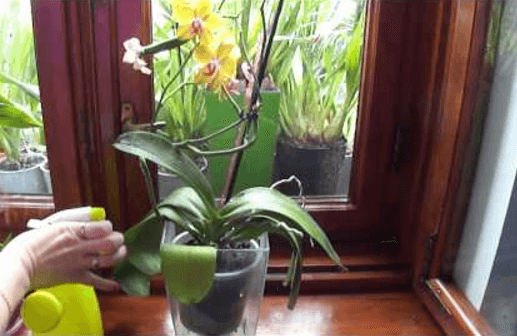
Spray the plant only in the summer
During the growth period, the plant is fed every third watering. This must be done carefully, as the orchid is very sensitive to. If you overdo it, she can get sick.
Top dressing should be root and foliar. When foliar top dressing, the ground part of the plant is sprayed with highly diluted fertilizers. You need to feed the orchid with the alternation of these two methods.
You can buy ready-made fertilizers for orchids in the store. The plant needs to be fed regularly with fertilizers with a high nitrogen content. After the flower grows up, it will need a lot of phosphorus. It is also recommended to spray it with a growth stimulator once every 3-4 weeks. A few hours after spraying, the remnants of the drug are washed off the leaves with a cloth.
Temperature and lighting
The ideal temperature for an orchid in the summer months is 24-28 °, in winter - 15-18 °. Short-term deviations from these parameters are acceptable, long-term deviations are undesirable, as they can cause yellowing of the leaves and wilting of the whole plant.
In summer, you can put a flower on a balcony or in a garden. But the place must be protected from drafts. The plant does not like this very much. Drafts can cause him irreparable harm.
A lot in growing orchids depends on lighting, as it regulates and stimulates the flowering process. Lighting can speed up the onset of flowering, or it can slow it down. An interesting fact is that plants with white and pink flowers less photophilous than with yellow or red. This must be taken into account when placing flower pots.
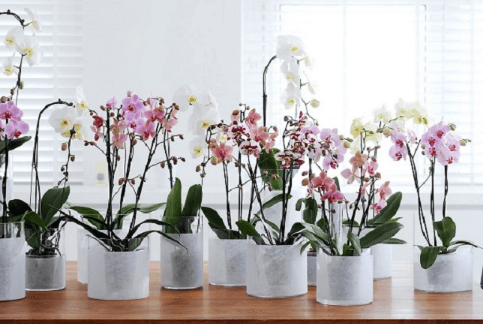
The best place for an orchid is the south side
If the windows face the north or east, the orchid may not bloom at all or even get sick. In this case, you need to look for a new place for it or install a fluorescent lamp nearby. Therefore, if possible, it is better to keep flower pots on the south or southwest sunny side.
You can determine that there is little light by looking at the leaves. If they are dark green, then this indicates that there is not enough light. If the leaves began to turn yellow, then urgent action must be taken by creating additional sources of light.
If the leaves have acquired a light green color, then the sun, on the contrary, is too much. In this case, the plant must be removed to a place with more diffused lighting.
Bloom
Orchid Dendrobium nobile begins to bloom in January. Flowering lasts 8-12 weeks.
The duration of flowering depends on care. It is very important to observe the temperature regime during flowering, otherwise the leaves will turn yellow and the flowers will fall off.
After the end of the flowering period, they are removed from the sunny side for 2 weeks to give it a rest. At this time, neither active watering nor transplantation is needed. After two weeks, the plant is returned to its old place and watering is resumed.
Feeding is reduced so that the orchid regains strength for growth and the next flowering. It must be taken into account that in this case it can shed some of the leaves. This is normal and you don't need to do anything about it.
If an orchid has yellow, purple or red flowers, this means that it comes from places with a difficult climate, where hot, dry weather lasts for 2-4 months. During such a period, orchids exist only at the expense of their own reserves.
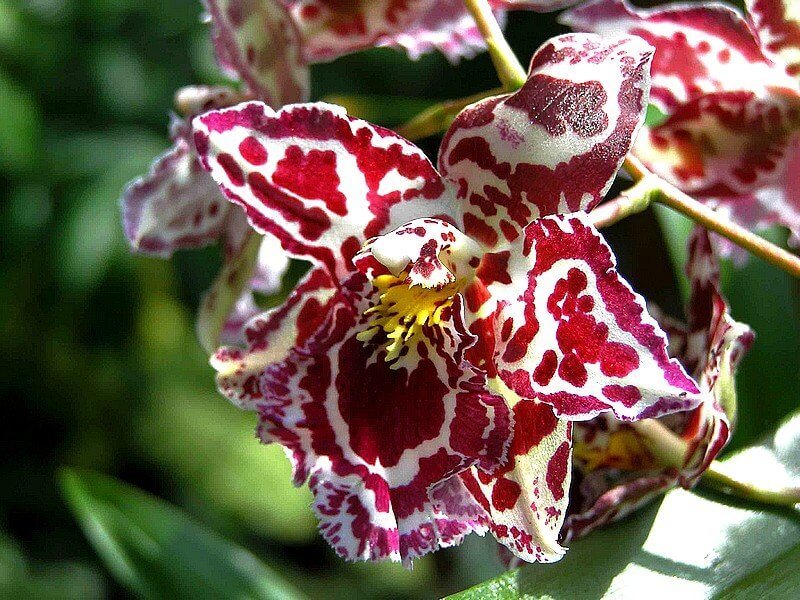
An orchid can be of various colors, but it depends on the climate.
They begin to bloom at the end of the drought period. This feature must be taken into account when. It is important to create similar conditions for them when grown on a windowsill.
As soon as new sprouts on the orchid release leaves, you need to move on to stimulating flowering. Watering is gradually stopped so that the soil dries well between waterings and stands dry for at least five days. This happens for 3-4 weeks. Then watering is completely stopped.
The orchid is removed from direct sunlight and taken out to the balcony or garden. At night, it will cool down to 18-24 degrees, absorb a large amount of carbon dioxide and give impetus to flowering.
In order not to waste time, you should try to stick to the following schedule:
- Option I: from late autumn to mid-February hibernation, after that 6 weeks of activation;
- Option II: 5 weeks of activation before hibernation and 1 week after it.
With the formation of flower stalks, the air temperature should become higher, watering is resumed in the same volume. If the plant has not been watered for a long time, it could lose some of the roots during this time and will not be able to absorb all the water from. In this case, the volume of watering is increased gradually.
Thus, if you buy a light-colored orchid, then it does not need a hibernation period, if it is bright saturated tones, then you need to act as described above.
Propagation of Dendrobium nobile
At home, the Dendrobium nobile orchid is usually propagated vegetatively. Bulbs are divided into 2-3 parts. Each part of the bulb is planted in the soil prepared in advance.
The orchid is propagated after it regains strength at the end of flowering. Best time for this the beginning of autumn.
Another way of reproduction is by babies (they are also called cakes), which grow on the bottom of the stem.
When they start up roots 2-3 cm long, they must be separated and planted in separate pots. Pots should be small and cramped, as the roots of the Dendrobium nobile orchid love tightness. When planting, care must be taken not to damage the roots, they are very sensitive.
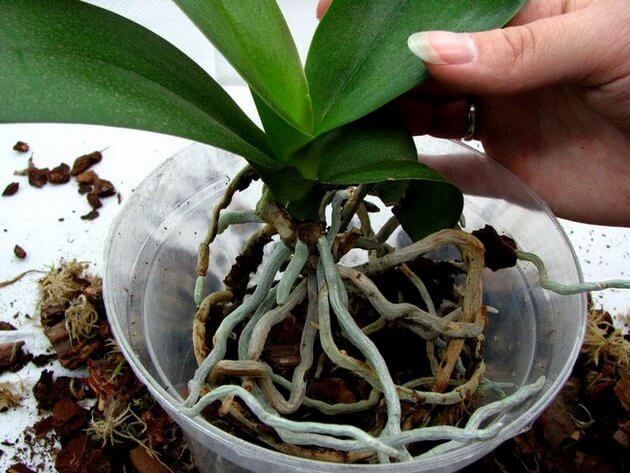
When transplanting, the main thing is not to damage the roots.
You can use the method by cutting off the faded stems and placing them in wet sand.
You need to cut as low as possible, almost on the border with the soil. The sand in which the cut stems will be located must be constantly wet. As soon as roots appear on them, they are transplanted into pots.
Sometimes the orchid is propagated by dividing the bush. They dig it up, shake off the roots from the ground and with a clean knife divide the bush into four parts. Each part should have its own root system, several buds and several stems.
Affected areas are treated with garden pitch. They start blooming this year or next.
There is another way of reproduction - seeds. It is used in greenhouses. This is a very difficult way.
orchid pests
When an orchid is brought home from the store, it should be immediately checked for pests. An external examination will not give anything, because pests and their larvae can hide in the soil itself.
To examine the plant, the flower pot is placed in a container of water. The water level should be below the rim of the pot. In about five minutes, all the pests will climb out. They must be caught and thrown into a container with kerosene.
The main types of pests that can affect the Dendrobium nobile orchid, we will consider further.
Ticks
Spider mites - infect leaves, leaving white dots of punctures. The leaves turn white and discolor, then turn brown and die. Flowers fall without opening. There is a thin web on the leaves.
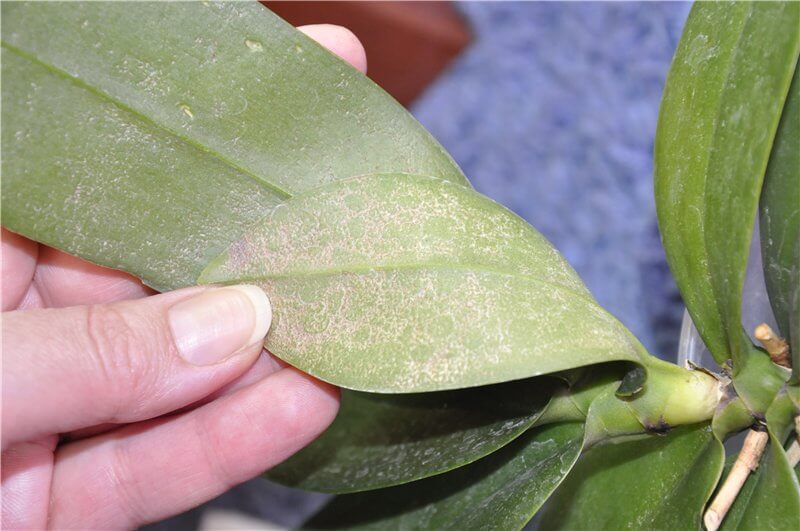
With a tick, the plant does not have time to bloom
- The treatment consists in increasing the humidity and spraying with fitoverm 3 times with an interval of 10 days;
Flat mites - suck the juice from, because of which the leaves on the underside become silvery with a brown tint. Flowers fall without opening.
- Spraying with fitoverm 4 times in 4 days and, as in the previous case, increase the humidity;
Bulb mite - affects the roots and leaves at the base. It penetrates the roots, gnaws everything inside. The roots become empty inside.
- Sick root parts are cut off, the soil is abundantly watered with fitoverm;
shell mite - its appearance resembles a black shiny pea. Lives on leaves, feeding on their juice. - Ticks are collected by hand, the soil is shed with fitoverm.
Other pests
False shield - rounded shape of brown color. When it is damaged, light brown and yellow crusts appear on the leaves. If this crust is knocked off, then pests themselves are found under it, which drink the juice from the plant. In this case, the stem and leaves must be washed, cleaned and sprayed with fitoverm. It is done twice with an interval of 7-10 days;
Shield - resembles in appearance a piece of a match head glued to. In the affected areas, dark spots and wounds are formed, which are treated with brilliant green or sprinkled with charcoal. As in the previous case, the leaves are washed, cleaned and sprayed with fitoverm.
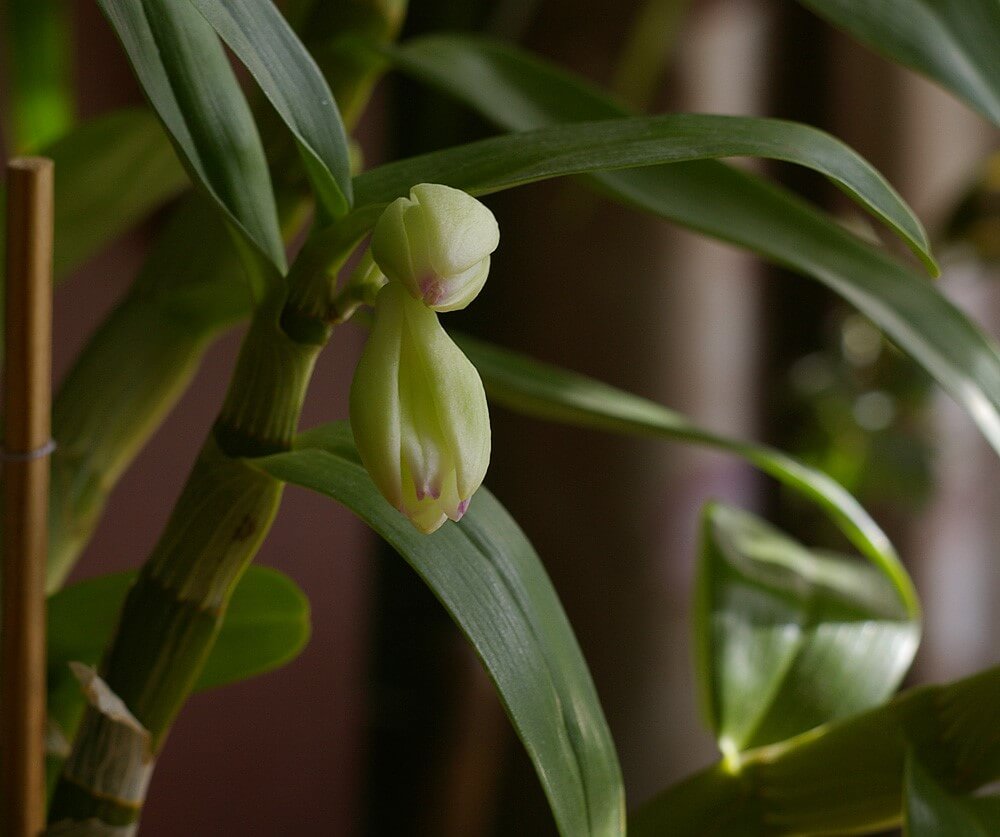
Scarlet - looks like a piece of fleece, white and fluffy. Very dangerous pest because it drinks the juices from the plant. Leaves turn yellow and fall off. It can get on the plant along with dust from the wind or soil from the store. It lives in the axils of the leaves, in the roots.
To cure the plant, it is necessary to remove the scales, dry leaves. Every day it is necessary to inspect the flower, pull out the worm, and wipe the sore spots with a cotton swab dipped in water or soap. The whole plant will have to be sprayed with fitoverm 2 times in 7-10 days. To prevent this from happening again, the leaves are washed once every 5 days.
Whitefly - a small white butterfly, just like previous pests, sucks juices from an orchid. The leaves turn yellow, the plant withers and gets sick. She flies very fast, it is difficult to fight her. Eggs with larvae are hidden under leaves and bark.
To cure, wash the leaves with laundry soap in a ratio of 1:6. The plant is sprayed with Actellik 2 times in 7-8 days. For prevention, once every 5 days, the leaves are wiped or washed.
Thrips - the smallest midges 2 mm in length. They look like small black sticks, running fast and with wings.
Thrips sit on the plant and try to hide in the ground. In order to watch for them, it is necessary to approach the plant in the dark with a flashlight. They lay their eggs inside the leaf. The larvae feed on leaf tissue, which causes spots on the leaves and they die. To cure, it is sprayed with Actellik, washed and wiped with leaves.
Only if all the conditions and rules for care are observed can pests and problems be dealt with.
While watching the video, you will learn how to properly care for an orchid.
Flower growers have to experience a lot of difficulties in the process of caring for the Dendrobium nobile orchid, because this flower is very capricious. But in gratitude for the care, he will give his wonderful aroma and beauty, which will delight for many years.
Noticed an error? Select it and click Ctrl+Enter to let us know.
General information
Buying an orchid with the inscription dendrobium in a flower shop, a person buys an orchid - a hybrid. Real natural species are difficult to buy in a store. They can be found predominantly in nurseries and botanical gardens, where they are used to breed new varieties.
In the purchased hybrid, in its composition, there is a certain proportion of Dendrobium, most likely an orchid - Dendrobium nobile, but besides this, it may also contain a share of Cymbidium, Paphiopedilum, Phalaenopsis, or some other orchid.
Depending on what species are included in the purchased hybrid, it may have different requirements for humidity, temperature and dormancy. However, despite some differences, growing a dendrobium orchid at home is not difficult.
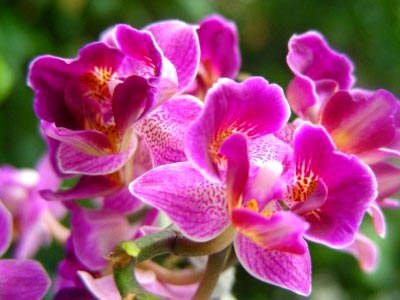
Dendrobium orchid home care
Light plays a very important role in growing orchids. It is on how the plant is illuminated that the root growth, development and growth of leaves depends. In addition, flower stalks appear from the right light. In winter, with a small amount of light, the plant almost does not grow at all. Even if the temperature in the apartment is high. Also in winter there are no new shoots, although the bulbs continue to develop.
Orchid dendrobium home care in the spring is actively growing, so it is best to keep the plant at this time in a warm and sunny place. In such conditions, a rapid increase in green mass will occur, and the dendrobium orchid will bloom earlier. Due to the variety of hybrids, it is difficult to say unequivocally which window is best for any particular orchid. You just need to experiment.
But it is believed that the southeast windows, southwest and south are suitable for any orchids. It is also known that plants with white flowers need less good lighting than plants with bright saturated flowers.
With the onset of summer, it is useful to expose orchids to fresh air. The place must be protected from wind, rain and direct sunlight.
Dendrobium orchid home care can be done in a fairly wide temperature range. Some plants can easily withstand temperatures as low as 0 degrees. But the most favorable temperature for the development of orchids and flowering is no more than 32 degrees in summer, and in winter - about 10-20 degrees. Such a big difference in the temperature regime is due to the fact that under the same name of the plant - "dendrobium orchid" a wide variety of all kinds of hybrids are sold in stores. By the behavior of the plant, it is possible to determine what temperature it needs at different times of the year.
You also need to know that the orchid evaporates a large amount of moisture at a very high temperature. environment. And the root of the plant loses its ability to absorb moisture and the process of root drying begins.
Dendrobium orchid home care is a big influence in which is the difference between night and day temperatures. The temperature at night should be lower than during the day. It is better if it does not rise above 19 degrees. This is necessary so that orchid hybrids can develop. Growing dendrobium orchids is useful in the warm season outdoors. This ensures the natural regulation of night and day temperatures.
Dendrobium orchid home care perfectly adapts to low humidity. IN natural conditions many species of natural orchids sprout in places where prolonged rains and prolonged drought alternate periodically. But orchid hybrids are unique in that they can successfully grow and develop in ordinary houses and in greenhouses with high air humidity.
This is simply due to the fact that in these plants the chemical processes proceed a little differently than in wild plants. When air humidity is low, orchids consume a large amount of moisture with the help of roots, and evaporate it with leaves and stems. At high humidity levels, the absorption of moisture by orchids decreases.
It is desirable to spray the plant in the warm season with a lack of moisture. In winter, the dendrobium orchid does not need to be sprayed.
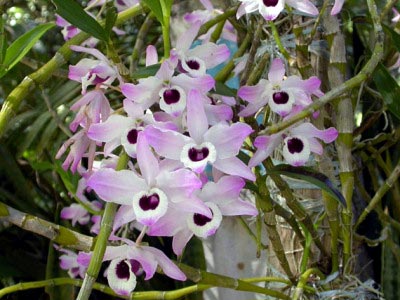
orchid dendrobium watering
The abundance and frequency of watering home orchids directly depends on the temperature regime and the level of sunlight intensity in the house. The lighter and warmer the house, the more you need to water the plants. In winter, plants should not be watered much. When an orchid's growth is slowed or stopped, frequent watering will likely cause the plant's roots to rot. It is impossible to accurately determine the period between waterings, since it is different for all orchid hybrids. In addition, it changes at different times of the year. Skillful flower growers give advice to pay close attention to the substrate of the plant. It must be dry before the next watering.
The water that Dendrobiums and Phalaenopsis are watered with should be soft and certainly warm (30-36 ° C). In addition, a warm shower is favorable. It is used to cleanse the pores of the leaves and has a beneficial effect on the plant as a whole.
Active growth of orchids begins in spring and continues in summer. At this time, fertilizing should be done with every third watering. To feed the plants, a special fertilizer for orchids is used in half concentration. In addition to these top dressings, it is useful to carry out spraying with a highly diluted fertilizer, the so-called foliar top dressing of the plant.
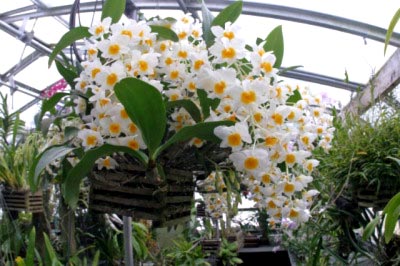
Dendrobium orchid transplant at home
Growing a dendrobium orchid can be done in any way that exists for exotic plants. For example, it is perfectly acceptable to plant orchids in pots or to mount plants on blocks. Orchid pseudobulbs can grow sideways, or be long and stretched upwards, then the plant will lose stability.
To avoid this, the dendrobium is planted in a large, massive flower pot. There is also a hanging planter. The plants in it just hang down. Dendrobium orchid should not be transplanted often. A transplant should only be done if the orchid no longer fits in its pot. When a flower is watered with hard water, over time, the substrate becomes unusable. Therefore, after two years it will be better to replace it with a new one.
To choose the right pot for an orchid, you need to take into account its size relative to the size of the plant's root system. There should always be free space in the pot from the roots of the plant to the walls. As in pots with other plants, large stones should be placed in the bottom of the orchid pot. This is done for drainage and so that the orchid can grow and become stable in its pot.
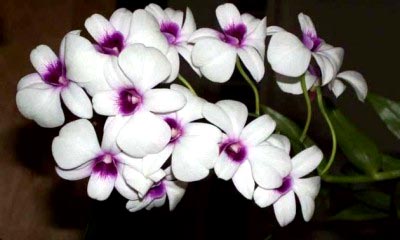
Soil for dendrobium orchids
The usual store-bought orchid soil mix can be bought at the store. However, the mixture can be prepared by yourself at home. Florists buy and use all sorts of mixtures to grow dendrobiums, from pure bark to sphagnum moss.
With all this, it must be borne in mind that the most loose soil is suitable for dimly lit rooms. But for orchids that grow on sunny southern windows, a substrate with a lot of moss is more suitable, which will retain moisture.
In the wild, under natural conditions, orchids enter a dormant period when drought begins. This means that its growth stops before the rainy season. When growing orchids at home, the rest period is forced and lasts all winter. This is due to the fact that chemical processes under the influence of low light levels become progressively slower. The plant stops growing and, as it were, "goes to sleep."
The most important thing at this moment is not to overdo it with watering. After all, water is almost not absorbed during the dormant period. In order to increase evaporation from the leaves, it is necessary to make the air temperature lower (up to 10-17 ° C) during the period of short winter cloudy days.
Certain hybrid orchids need a dormant period in order to bloom later. Moreover, these are precisely those that germinate in areas where the drought lasts 4 months a year. Under natural conditions, they begin to bloom with the arrival of rains.
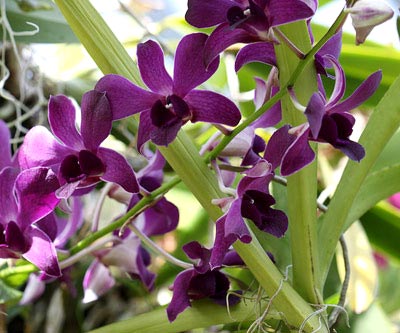
orchid dendrobium reproduction
The dendrobium orchid propagates at home in a vegetative way: the bush divides and the children separate.
Small shoots (babies) of an orchid can appear anywhere on the mother plant. Each process is separated only at the moment when they begin to actively grow leaves and roots and are planted in separate pots. Sometimes it is better to cut off the shoot with the old bulb together so that the bulb gives all its nutrients to the young baby.
The easiest way is to divide an adult plant into parts so that 2-3 pseudobulbs are obtained on each part. It is advisable to dry the cut thoroughly before planting. You can also sprinkle the cut with charcoal. This will prevent the decay process.
But the tacca Chantrier orchid reproduces not only vegetatively, but can also be propagated by seeds. You will find all the information on home care here.
Dendrobium nobile (Dendrobium Nobile) is a herbaceous perennial plant belonging to the orchid family. Common names: Dendrobium nobile, D. noble, D. famous, D. excellent, D. glorious, D. conspicuous, D. famous, D. noble. A large number of names are due to the presence of the Latin word "nobilis", which in translation has many meanings.
It got its name from the Greek words "dendron" ("tree") and "bium" ("life"); it turned out "the one who lives on a tree", that is, an epiphyte. Today we will talk about what kind of care for the dendrobium nobile is needed at home. In the event that you are a beginner grower, but you really like orchids, I recommend that you buy a dendrobium nobile flower, which is easy to grow and maintain. Dendrobium nobile is a plant that purifies the air in the apartment by absorbing formaldehyde.
Distribution and habitats
Dendrobium is a huge genus of orchids, consisting of 1200 species. The genus comes from various habitats, most of south, east and southeast Asia, Borneo, Philippines, Australia, Solomon Islands, New Guinea and New Zealand.
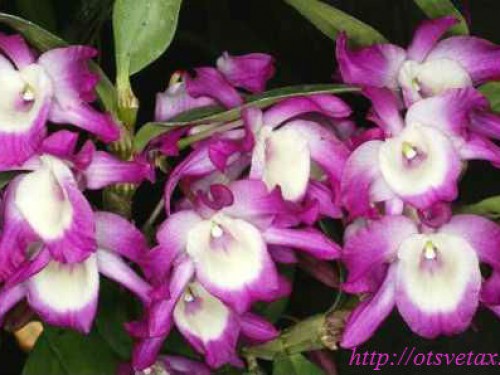
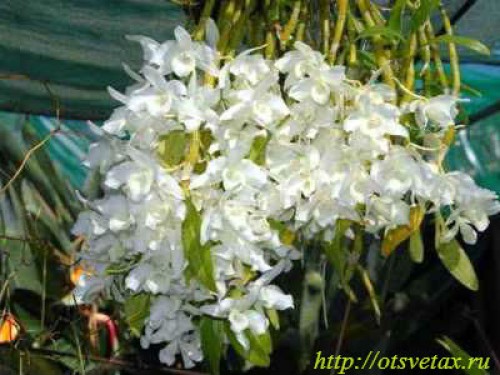
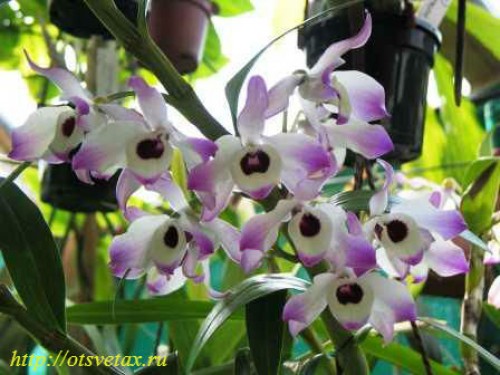
Dendrobium species are both epiphytic and lithophytic, plants living on rocky surfaces. The dendrobium plant has adapted to a wide range habitats, from high altitudes in the Himalaya mountains to low-lying rainforests and even in the dry climate of the Australian desert. Dendrobium Nobile is one of the most popular flowering indoor orchids.
Description
Dendrobium nobile or Dendrobium noble is a sympodial orchid that forms pseudobulbs. At a young age, the pseudobulbs are erect, as the plants grow older, the pseudobulbs droop.
Pseudobulbs are green-yellow, narrow and straight, up to 1.2 m long, crowned with several narrow leaves 10 cm long and 2 cm wide. When ripe, the pseudobulb turns yellow and sheds its leaves. The life cycle of a pseudobulb is 2-4 years. Children are formed on the tops of old pseudobulbs. One pseudobulb can produce 10-70 flowers with a diameter of 6-9 cm.
The leaves are lanceolate and linear in shape, formed in early autumn. In late spring, the pseudobulb sheds its leaves and changes to branching flower stalks. Dendrobium flowering in the period January-March. Petals and sepals with wavy edges. The lip is large and rounded, with a tubular base. The color varies from pink to dark purple, but the lip always has a maroon spot in the center.
Dendrobium orchid home care
Bloom
Flowering usually lasts for two to three months. Flowering will last longer if the plant is in a cool, dry place away from batteries and direct sunlight.
Lighting
Bright light is needed all year round, but I do not recommend direct sunlight, so it is better to slightly fence off the plant with a translucent film or curtain.
Temperature
During the active growth period, keep the plant in the temperature range of 15-21 °C and spray it daily. In winter the temperature is 15-24°C during the day and 10-13°C at night. The orchid can be put outdoors in the summer.
Watering
From the moment of budding and then throughout the entire growing season, the dendrobium nobile plant must be watered abundantly. Let the soil dry completely before the next watering. Do not let water droplets fall on young sprouts, the wet state of the sprouts will cause them to become sick. During the dormant period, the plant is given enough moisture to keep the substrate from drying out. Basically, the abundance and frequency of watering directly depends on the air temperature in the room, the higher the temperature, the more often you need to water.
Transfer
Use any substrate recommended for orchids. The plant is best grown in a small regular pot with plenty of drainage material. A dendrobium orchid with eight pseudobulbs can thrive in a 10 cm pot. Transplant your dendrobium nobile to a larger pot only when the pot is full of plant. This is best done in the spring, just as new growth begins.
reproduction
To divide a large bush. Each individual part should have up to four pseudobulbs. Cut off and discard dead, brown pseudobulbs. Plant each piece in an 8cm pot of standard orchid mix and water until new growth appears. Reproduction can be done with the help of children (lateral processes) that grow on a pseudobulb. Children whose roots are 4-5 cm long can be safely separated and planted in pots.
Diseases and pests
Dendrobium nobile is susceptible to attack by red spider mites. Cut off infected leaves and adjacent stems and spray the plant with pesticides. Whatever substrate you use, it should be open enough to keep some air around the roots. The Dendrobium Nobile orchid cannot tolerate wet, damp substrates, which will inevitably lead to root rot.
Application
Dendrobium noble indoor plant which will make a living decoration as it is more durable than many cut flowers. Dendrobium nobile hybrids are amazing pot plants. In their upright position, they look exactly like a living bouquet, the flowers are so closely pressed together that it becomes difficult to see the stems under the flowers.
Dendrobium nobile is a pleasant exotic decoration not only for living quarters, but for offices, as it is easy to care for and blooms for a long period. Used as cut flowers, it can stand in a vase from 15 to 60 days.
Characteristics:
Leaf color is green. Features - beautifully flowering. The form of growth is vertical. Height: 1.2 m.
The basics of caring for a dendrobium orchid: Watering during the dormant period is moderate. Watering during the growing season is plentiful. Light is bright. Dormant temperature - min 10°C max 18°C. Active growth temperature - min 16°C max 21°C.
Dendrobium nobile photo
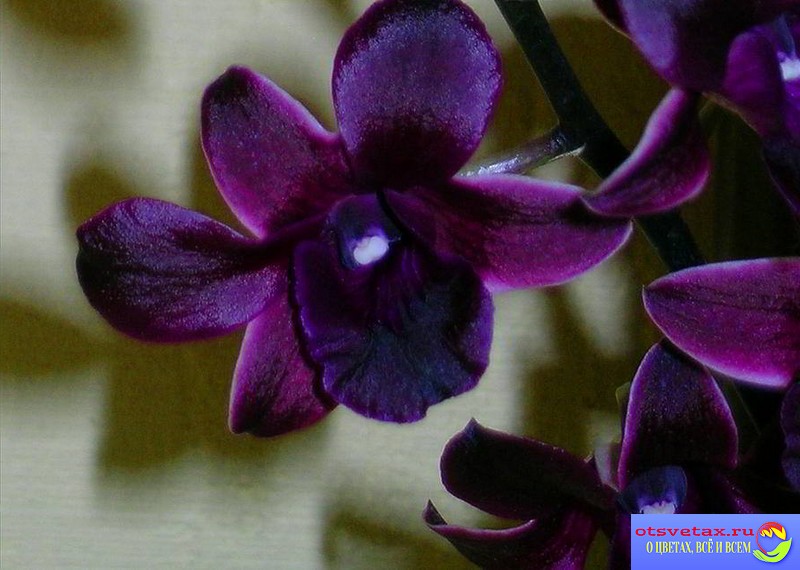
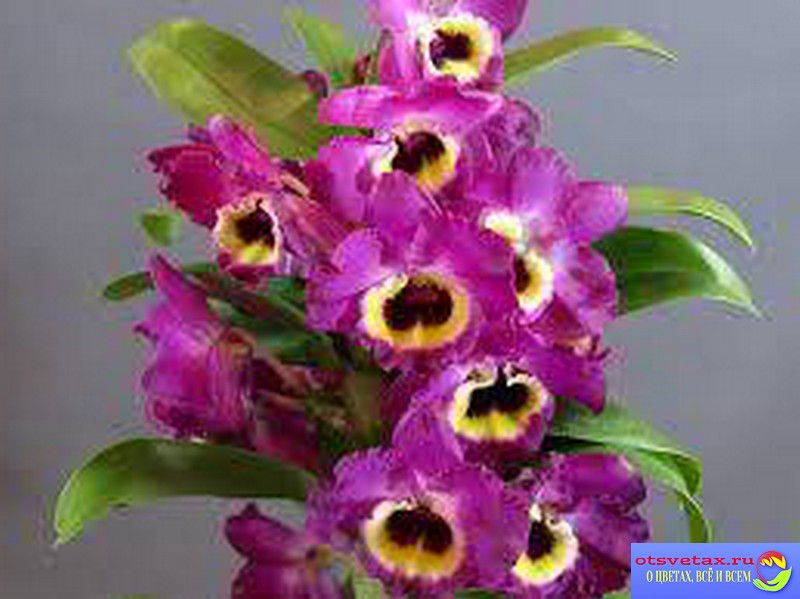
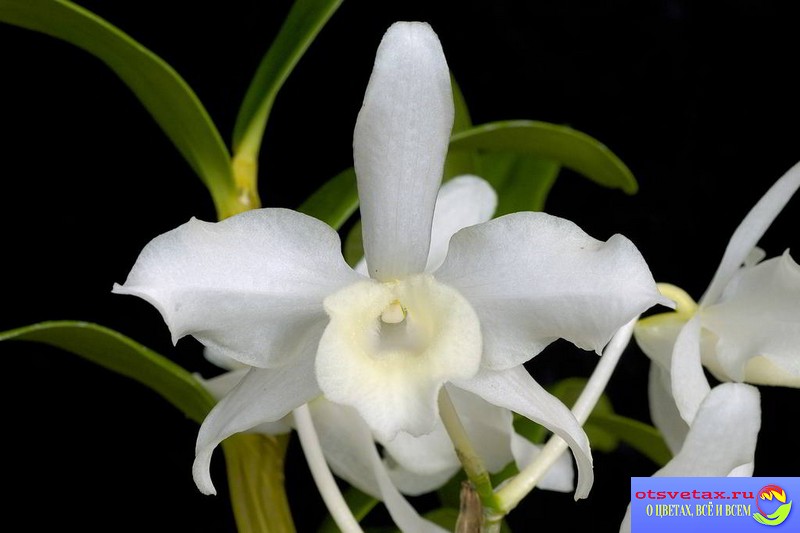
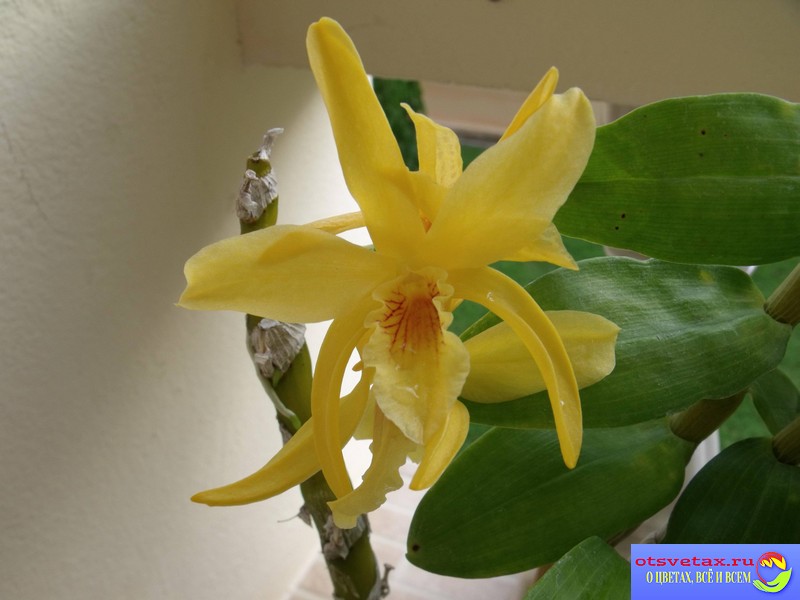
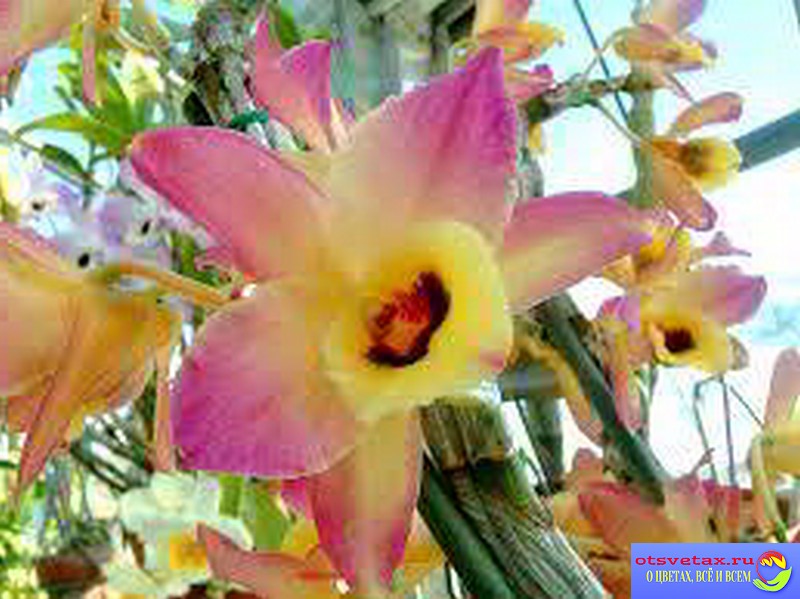
Dendrobium nobile care after flowering
What to do with dendrobium nobile after flowering? Do you need pruning after flowering or not? Such questions can be found on many forums dedicated to orchids. I will try to answer these questions concisely and correctly.
Dendrobium noble (nobile) does not need pruning after flowering, like the Phalaenopsis orchid. This happens because the dendrobium has pseudobulbs connected to each other. Each individual pseudobulb blooms only once. On an already faded pseudobulb, flower buds that do not bloom in the first flowering may bloom.
You should know that along the entire length of the pseudobulb there are buds capable of flowering. Therefore, if the buds appeared on one side, you should wait until all the buds on the pseudobulb have faded. Novice flower growers often cut off a faded pseudobulb, which leads to irreversible disease processes and the death of an orchid.
It is impossible to cut off the pseudobulb, in which all the buds have faded, since the old pseudobulb is the organ that feeds the young shoots during the growing season. You can cut the pseudobulb only when it begins to dry out and the leaves fall off. The bulb is carefully peeled off at the base, the cut is treated with activated charcoal (cinnamon).
Video - how to properly care for a dendrobium orchid
Dendrobium is a perennial herbaceous plant of the Orichidaceae family. They got their name from the Swedish botanist Olaf Schwartz, who in 1799 combined two Greek words. One of them was "dendron" - a tree, and the second "bios" - life, that is, the name dendrobium is translated as "living on a tree." Dendrobium is native to Australia, South Asia and the islands of Polynesia.
Dendrobiums are herbaceous epiphytic plants. They are deciduous or evergreen orchids. Dendrobium shoots can be cylindrical, ribbed, smooth. In almost all species, they are thickened and girdled with membranous tissue. The leaves most often grow along the entire length of the stem, but may only grow from the top. The shape is oblong elliptical or ovoid. Sometimes quite dense, similar to succulent. Dendrobium flowers are varied in color, shape and size.
Dendrobium orchid types and photos
At the moment, about 1200 types of dendrobium are known. Natural species go on sale much less frequently than hybrids created on their basis. You can buy them in nurseries and botanical gardens, where they are used to breed a new species. The following species are best suited for growing at home: Dendrobium noble, Dendrobium moniliforme, Dendrobium densely colored, Dendrobium Kinga, Dendrobium Parish, Dendrobium phalaenopsis.

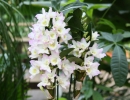
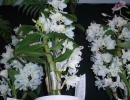
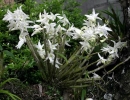
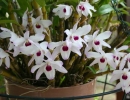
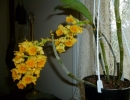
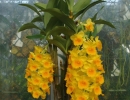
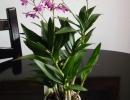
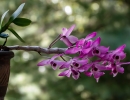
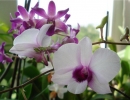
Noble Dendrobium (Dendrobium nobile) is one of the most popular and widespread species in culture, it has more than 80 varieties. The name of the species is derived from the word "nobile", which means "famous, noble, conspicuous".
Orchid Dendrobium noble is a large epiphytic plant up to 90 cm high. Its stems are large, fleshy, swollen. The leaves are located on both sides of the stem, have an oblong elliptical shape. Short peduncles develop 3-4 flowers up to 10 cm in diameter. Flowers vary in color from white to deep purple. The lip is white with a large dark purple spot. Most often blooms from January to May.
![]()
In the photo, dendrobium moniliforme
Dendrobium moniliforme (Dendrobium moniliforme) is a Japanese endemic orchid that resembles Dendrobium nobilis but is much smaller. The size of an adult plant is about 15 cm, and it begins to bloom reaching only 5–6 cm. The flowers are pink-white, fragrant. Blooms from late winter to early autumn.
Dendrobium densely colored
Dendrobium densiflorum (Dendrobium densiflorum) is an upright epiphytic orchid. Tetrahedral stems thicken and have rather pronounced nodes, on top of which 3–4 leaves grow. The leaves are narrow, elliptical or lanceolate, rather fleshy and smooth. Dense inflorescences are collected in sagging brushes, which consist of a large number of flowers (from 50 to 100 pieces). Lip pubescent, yellow-orange. The flowers are yellow-orange in color, their diameter is not more than 5 cm.
King's Dendrobium (Dendrobium kingianum) is a small epiphytic orchid. It has rigid cylindrical stems thickening from above. The leaves are located on the upper part of the stem in 3-4 pieces, lanceolate, up to 30 cm long and 3 cm wide. The flowers are small, collected in a brush, have a color from white to bright purple. The flowers are very fragrant, up to 2 cm in size. A feature of this species is the folded tubular base of the lip around the column. Flowering begins in February, lasts for two weeks.
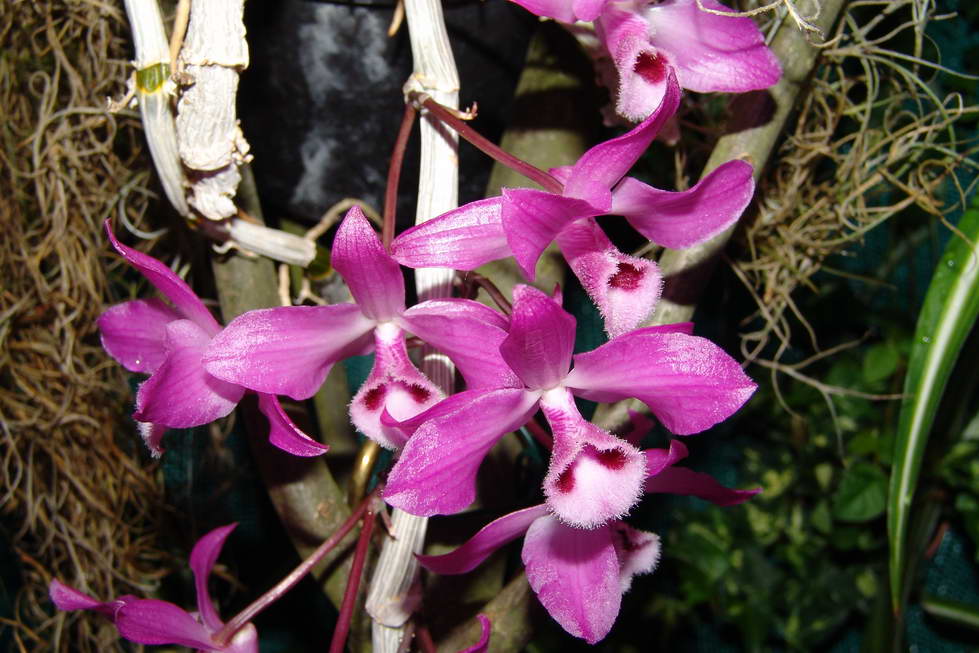
Pictured is Dendrobium Parish
Dendrobium Parish (Dendrobium parishii) is an epiphytic deciduous orchid, reminiscent of Dendrobium noble. Its stems are thick, hanging, up to 40 cm long. The leaves are oblong, lanceolate, with a small incision at the end. Inflorescences few-flowered. Flowers up to 10 cm in diameter, pink to lilac. The lip of the flower is diamond-shaped or round, pink or white, decorated at the base with two dark purple spots. Blooms in spring or summer.
Dendrobium phalaenopsis
Dendrobium phalaenopsis (Dendrobium phalaenopsis) is a large semi-deciduous orchid. Stems are long, erect, fleshy. Thicken towards the top and have a length of up to 60 cm. The leaves are lanceolate, long, grow in the upper part of the stems. Peduncle reaches 60 cm in length. Large flowers, which are up to 9 cm in diameter, are painted in lilac-violet hues. It blooms from November to January, the flowering period is 5-6 weeks. At the moment, a large number of subspecies of Dendrobium phalaenopsis have been bred, which differ in the period and duration of flowering, as well as in the color of the inflorescences.
Growing and caring for dendrobium at home
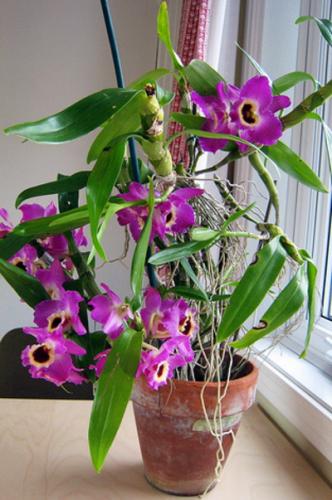
Most types of dendrobium orchids are light-loving, they need to be placed where there is bright diffused light.
Due to the huge number of dendrobium species and the vast geography of their natural habitat, each type requires its own approach. Most often, dendrobium hybrids are purchased for home breeding, they are most adapted to indoor conditions, and have similar care recommendations. For growing dendrobium, it is better to have experience in floriculture.
The choice of location, lighting and temperature conditions for the dendrobium orchid
Almost all types of dendrobiums are photophilous and love bright diffused light. In order to avoid leaf burns, on a hot sunny day, you should remove the orchid from the window to a more shaded place. She needs the maximum amount of light in late summer and autumn when the shoots ripen. In winter, it is desirable to use artificial light for 4-6 hours a day. East and west windows are ideal for placement.
Temperature regime for different types dendrobium is significantly different. If you do not know exactly the type of plant being grown, then you need to carefully monitor its reaction to changes in temperature. During the growth period, high temperatures are suitable for almost all dendrobiums: up to 25 degrees during the day and up to 20 at night. For phalaenopsis, it is necessary to increase it by 2-3 degrees. After the end of growth, the temperature must be reduced to 12–15 degrees at night, and for Dendrobium noble to 10 degrees.
Watering and humidity
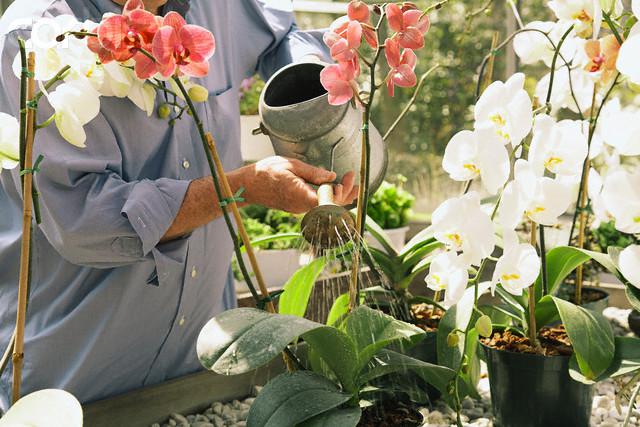
For watering the dendrobium orchid, it is necessary to use settled water, and its temperature should be at room temperature.
As a tropical plant, most dendrobiums prefer high humidity up to 60%. In the summer, they must be sprayed daily. Do not allow water to accumulate in the axils of the leaves. In winter, humidity can be increased using a pallet with expanded clay and water poured into it. In this case, the bottom of the pot should not touch the water.
During the growing season, the dendrobium needs abundant watering. The approximate schedule is 2 times a week. The accumulation of water in the pan is unacceptable; half an hour after watering, it must be drained. Orchids at rest are watered only after the soil is completely dry. Water for irrigation should be soft, separated, at room temperature.
Requirements for soil and top dressing of a flower
In stores, you can purchase special substrates for planting dendrobium. They should consist of coarsely chopped tree bark, charcoal and special moss. Ordinary soil cannot be used for orchids.
During the active growing season, the plant is fed with liquid fertilizer for orchids 2 times a month. You can also use a complex mineral fertilizer at a dose half as much as it is written in the instructions.
Transplantation and reproduction of dendrobium
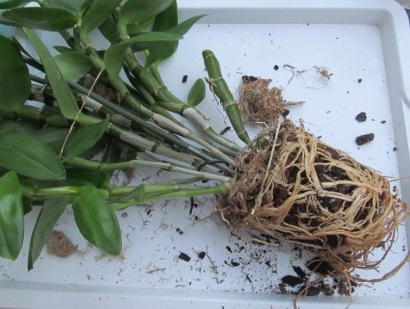
Dendrobium orchids are very painful to transplant
Dendrobiums are very painful to transplant, so it should be done no more than once every 2-3 years at the beginning of the active growing season. You need to transplant as carefully as possible, otherwise you may damage the plant. For transplantation, a special soil for epiphyte orchids or a mixture of pine bark, sphagnum, peat soil and charcoal is used. At the bottom of the pot, be sure to provide good drainage.
The dendrobium is propagated by dividing the bush or cuttings.
Propagation of dendrobium by cuttings
In this way, deciduous species of dendrobium can be propagated. To prepare cuttings, pseudo-bulbs are cut into pieces with 2-3 knots. The resulting nodules are placed in moistened sphagnum moss and wait for the formation of roots. Then you can plant them in the ground. For healing of cuts on the mother plant, it is better not to water it for about two weeks.
Propagation of an orchid by dividing a bush
This is the most popular way to propagate Dendrobium. It is best to produce it when transplanting an orchid, separating the shoots with their roots. Each "delenka" should have at least 2-3 pseudo-bulbs. They are planted in separate containers, watered and maintained at a temperature of about 22 degrees.
Growing periods for most types of dendrobium orchids
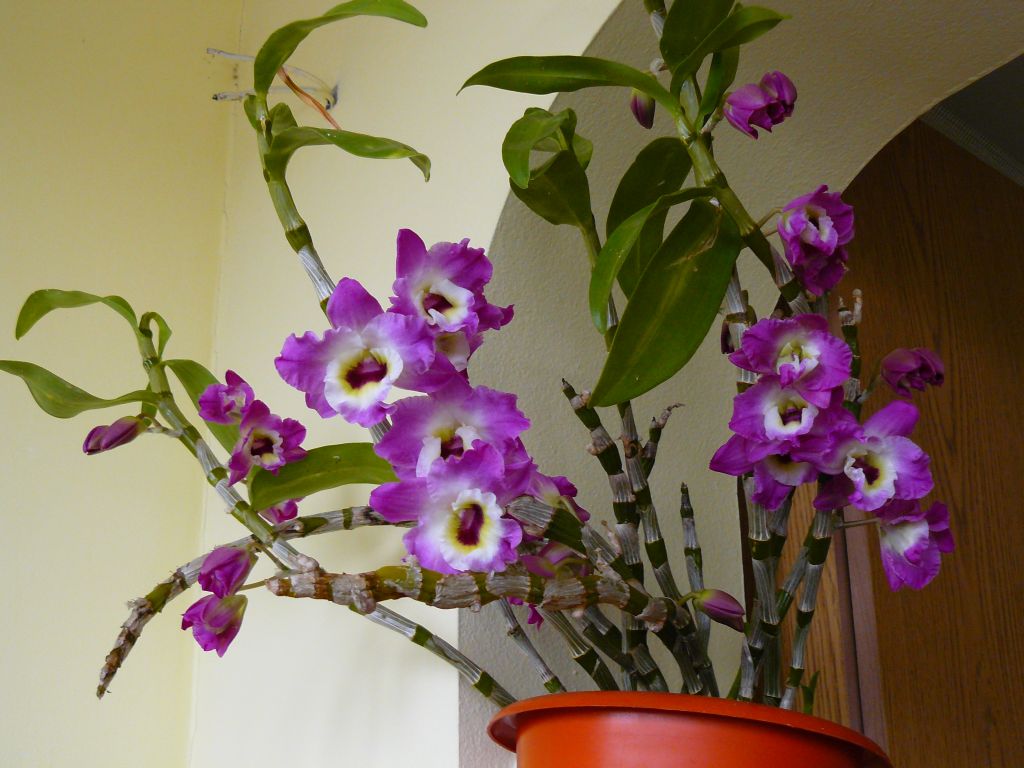
Blooming dendrobium orchids
Most dendrobiums bloom from February to May, with active ground growth of shoots and leaves from March to April. From May to September, the roots grow, and from September to February, the orchid goes into dormant mode and lays flower buds. These are approximate guidelines for which species or subspecies will have their own differences. Immediately after flowering is completed, you can transplant.
How to get dendrobium to bloom
In order for the dendrobium to begin to bloom, it needs to go through a full development cycle. Moreover, the time of year does not matter for this, only the temperature regime is important. For active flowering, he needs lower temperatures compared to the usual regime: about 18 degrees during the day and from 12 to 15 degrees at night. You can also stop watering the plant, thereby creating “stressful” conditions for it. Watering should be stopped until a new sprout appears. As soon as it reaches a length of 2 cm and roots appear, watering can be resumed.
Diseases, pests and possible problems when growing dendrobium orchids at home
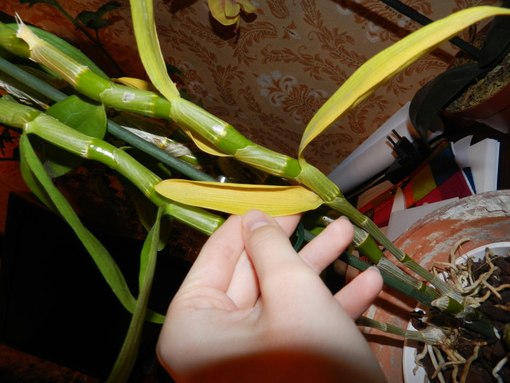
When the leaves of the dendrobium orchid dry, this may be due to the fact that the scale has curled on the plant
Improper care, as well as pest attacks, can lead to dendrobium diseases. Dendrobiums can be affected by such pests as: spider mites, aphids, scale insects and thrips. By the following signs, you can determine what exactly the orchid got sick with:
- grayish-brown color of the leaves, a silver sheen appears on their surface. Most likely the plant is affected by thrips. With a critical degree of damage, the leaves may fall off. Thrips also harm the surface of flowers: they deform and distort the color. Treatment is carried out with special preparations;
- leaves dry and fall. Maybe it has to do with shields. They are brown plaques on the surface of the leaf that suck the juices out of it. To combat it, the plant is washed with soapy water, and then treated with 0.15% Actellik solutions;
- stems shrivel. This is normal during the formation of new shoots and the dry period;
- the plant does not bloom, but actively forms children. This is due to a violation of the rest period or its short duration;
- the pseudobulb has turned brown or yellow. This is due to rotting from excessive watering;
- thin young shoots. This is the norm, they will begin to thicken after the end of growth;
No less important and interesting will be the video, from which you will learn some more useful information on how to care for dendrobium orchids at home, we wish you a pleasant viewing. If you have any questions, ask them in the comments.